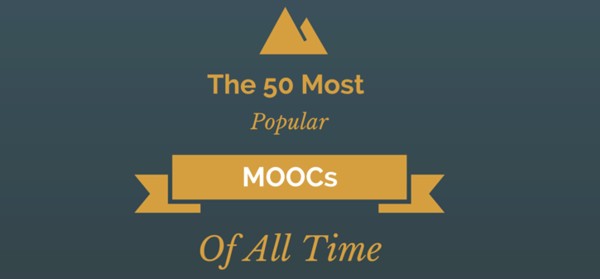| Top CS MOOCs By the Numbers |
| Written by Sue Gee | |||
| Wednesday, 11 November 2015 | |||
|
Online Course report has compiled a list of the 50 Most Popular MOOCs and exactly half of them come into the Computer Science category. OK we have to admit it, the IProgrammer team were quick to catch MOOC fever when it took off in 2011 and we've been keen proponents ever since. Well who can fault the idea idea of free, high quality, online Computer Science courses?
Inspecting the list of The 50 Most Popular MOOCs of All Time it was gratifying to count six computer science courses in the top 10 and to recognise all their titles as ones that we'd covered. In the case of this ranking "Popular" means the highest number of enrollments totalled over all the presentations to date. When the list was initially published the top slot was occupied by an Android course - Programming Mobile Applications for Android Handheld Systems – Part 1 on the Coursera platform. Since publication the list has been constantly revised as course providers eager to be higher in the league table have supplied updated figures about number of enrollments and this course, with "about 600,000" temporarily slipped to third position until an updated total of 678451 put it into second place. Currently the course with the greatest number of enrollments is one offerered by the British Council on the Future Learn Platform that helps non-English speakers prepare to take the IELTS, the world’s most popular English language test for higher education and global migration. It is not surprising that it should have had an even greater number of would-be students - the surprising thing is that it's actually not many more with a total of 690567. But that is over only two runs whereas the Android course, which is the starting point for Coursersa Mobile Cloud Computing with Android specialization track. has been offered several times since January 2014. The course that for a time came in at the 2nd most popular MOOC and is now 3rd is Cryptography I, one of five Stanford-branded Computer Science classes to be listed. This course, taught by Dan Boneh, was among the first to be run by Coursera when it launched as a platform in 2012 and has restarted at regular intervals since. According to has been run a total of 16 times and has clocked up around 600,00 students in total. The Computer Science classes that were the forerunners of today's Coursera and Udacity platforms are also included. Andrew Ng's Machine Learning course comes in at 27th but the figure quoted is 104,000 which is the total for the Autumn 2011 first interactive online version presented before Andrew Ng and Daphne Koller had, publicly at least, named their newly formed venture as Coursera. The course has been re-run several times - and had already reached a large audience as You Tube videos before becoming a MOOC and so certainly deserves to be higher in the rankings. UPDATE: Machine Learning is currently (March 2016) ranked 2nd with over 1 million students having taken it. Jennifer Widom's Introduction to Databases is credited with 64,127 student enrollments, giving it a ranking of 44th, but again this is likely to be an underestimate as 60,000 of these were for the original 2011 presentation. Reporting on the experience of taking her Stanford class online Prof Widom described it as: "one of the most rewarding things I've done". Explaining that on campus the course normally attracts around 100 students she admitted that it came as something of an eye-opener when 60,000 online students from 130 countries enrolled. She also revealed that of this initial number 25,000 submitted assignments and 6,500 achieved a strong final score. Last year the course was split up into 14 free, self-paced database mini-courses available on the Standford Online Lagunita platform. You'll also find the MITx class that was the forerunner of the edX platform, Anant Agarwal's Circuits and Electronics on the list and it too is now available as a self-paced course. Credited with 229813 enrollments it comes in at number 12 and it is another course for which we have facts and figures from the initial presentation, which some have interpreted as indicating failure rather than success: However when you consider where the drop-off happened, as illustrated in this chart:
you notice that 55% had already dropped out either before the course started (and some of this will be accounted for by people enrolling with multiple e-mail addresses) or when they discovered its level. Once you look at the pass rate as a proportion of those who submitted the first homework it is 27% - which is really quite impressive given that this was an really challenging course. If you want to know more about this see Harry Fairhead's account of the course and its exams. Peter Norvig and Sebastian Thrun's Introduction to Artificial Intelligence is in the list at number 23, credited with 160,000 enrollments. Again this is an underestimate as the were 140,000 on the original presentation of whom 23,000 successfully completed what was then a 10-week course. It is currently available in a self paced version expected to take 4 months to complete with 106,416 students. It was the outstanding impact of this class on its students that impelled Sebastian Thrun to launch Udacity. One of its initial offerings Introduction to Computer Science (CS 101) taught by David Evans is ranked 5th with a total in excess of 500,000 students which combines the original presentation as a week course and the subsequent self-paced (approx 3 months) version. The other Udacity course to figure in the list, ranked 16th, was one of four launched in April 2012 to provide a follow on from CS 101. CS253 - Web Development - How to Build a Blog is taught by Steve Huffman, who co-founded both Reddit.com and Hipmunk.com, has the aim building web applications and make your application scale to support large numbers of users and has attracted 218,051 students to date. Although Thrun's initial aim for Udacity was to provide high class university level education via this platform, he later changed the emphasis and it now focuses on providing education and training that prepares individuals for high tech careers and meets the needs of potential employers, see Start Your Career With Udacity Nanodegree. If you are looking for big-name university courses edX isa good starting point. Coming in at number 7, with nearly 350,000 enrollments, you'll find the highly popular (in terms of student ratings) CS50x. This is the online version of the Harvard Introduction to Computer Science course taught by David J. Malan and you'll find a full description in Students Flocking to Computer Science. CS50x is the course is recommended as the starting point in the Open Source Society curriculum for those wanting a complete curriculum for studying computer science for free. The next course in the OSS University list, Introduction to Computer Science and Programming Using Python, also on edX and from MIT is further down the rankings in 24th position with over 157431 students. Whereas CS50x covers C, PHP, JavaScript, CSS, HTML, and SQL this one, as its title indicates, is on Python, which is a popular choice of language for teaching CS. Udacity's CS101, already mentioned is also on Python and so is the course that is at 17 in the list, with almost 200,000 students, Learn to Program: Fundamentals. Its sequel. Learn to Program: Crafting Quality Code also appears in the list in 39th position with 76945 enrolled students to date.. This pair of courses is from the University of Toronto, an institution that is also represented with Geoffry Hinton's Neural Networks for Machine Learning which is 38th with 77.464 and, unfortunately, was only presented on one occasion in 2012 and despite its popularity with the students who took it, including some of the I Programmer team. |
Meta's MultiModal, MultiLingual Translator 21/01/2025 Meta has taken us a long way towards creating a Babel Fish, a tool that helps individuals translate speech between any two languages. This is thanks to SEAMLESSM4T which is open-source for non-co [ ... ] |
Go 1.24 Adds Generic Type Alias Support 17/02/2025 Go 1.24 has been released. This version adds support for generic type aliases, and is also faster. |
More News
|
Comments
or email your comment to: comments@i-programmer.info




